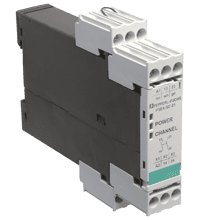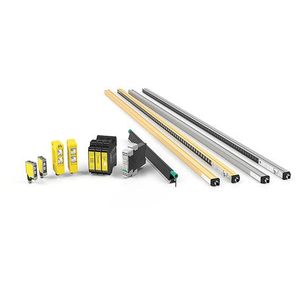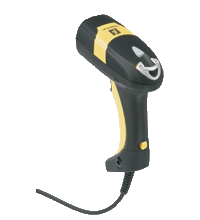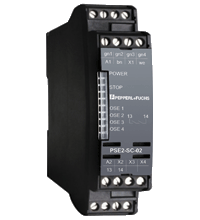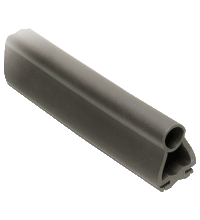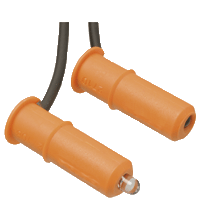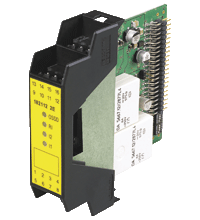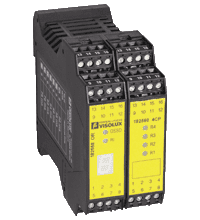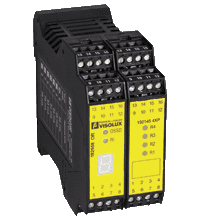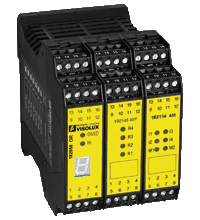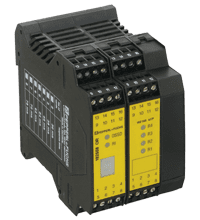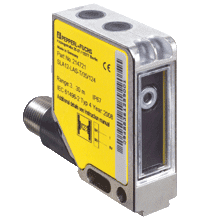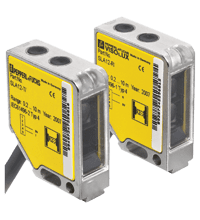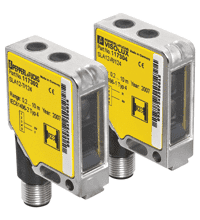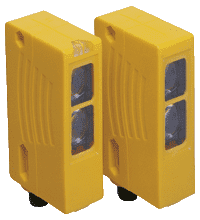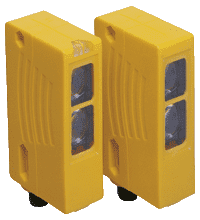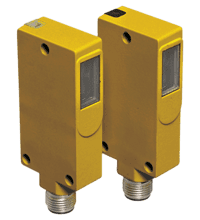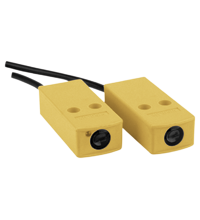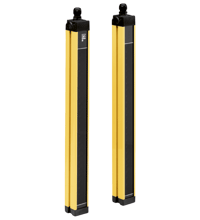Pepperl+Fuchs Safety Sensors
- Safety control unit
- For evaluating safety thru-beam sensors PSE4-SL
- Safety category 4 according to EN61496-1
- 24 V DC supply voltage
- 2 safe output contacts
- Performance level PLe (EN13849-1) is attainable
- Component of PSE4 modular system
Pepperl+Fuchs SLCS90-2400-R safety light curtain
- Type of protection: Class 2, type 4
- Number of receivers and emitters: 2
- Power supply voltage: 24 V DC
- Operating temperature range: -20...+70 °C
- Approved for Zone 1 and 21 (ATEX)
- Temperature range:
-10 ... +50 ?°C - Standard reading distance: approx. 60 - 1100 mm
- All 1-D standard barcode families supported
- Aiming system with a red spot for safety reading
- Functional reliability guaranteed after fall from 2 m
- Reliable reads damaged and dirty barcodes using the patented Puzzle SolveTM technology
- Triple green light (3GLTM) for good read feedback
- Safety control unit
- For evaluating safety thru-beam sensors PSE4-SL
- Safety category 3 according to EN61496-1
- 24 V DC supply voltage
- 1 safe output contact
- Performance level PLd (EN13849-1) is attainable
- Component of PSE4 modular system
- Aluminum mounting strip
- For mounting rubber sensor strips PSE4-RUB-30EPDM
- Simple to customize to application
- Possible to connect in series
- Component of PSE4 modular system
- Rubber profile
- For mounting to ALU mounting strip PSE4-ALU
- Simple to customize to application
- Versions up to 10 m in length are available
- Component of PSE4 modular system
- Rubber profile
- For mounting to ALU mounting strip PSE4-ALU
- Simple to customize to application
- Versions up to 10 m in length are available
- Component of PSE4 modular system
- Rubber profile
- For mounting to ALU mounting strip PSE4-ALU
- Simple to customize to application
- Component of PSE4 modular system
- Safety thru-beam sensor
- Evaluation via safety control unit PSE4-SC-01
- Modulated infrared light
- For mounting in sensor strip PSE4-RUB and -ROI
- No additional mounting materials required
- Component of PSE4 modular system
- Safety thru-beam sensor
- Evaluation via safety control unit PSE4-SC-01
- Modulated infrared light
- For mounting in sensor strip PSE4-RUB and -ROI
- No additional mounting materials required
- Component of PSE4 modular system
- OSSD-R/E-stop-module
- Safety outputs OSSD, external status displays OSSD
- 2 sensor channels
- Operating mode can be selected by means of DIP switches
- Start/Restart disable
- Relay monitor
- Stop function Cat.0 or Cat.1 and central stop function Cat.0
- Time function
- Screw terminals or spring terminals
- Sensor module
- 4 sensor channels
- Single module for safety thru-beam sensors SLA12 and SLA29 and for 2 channel safety devices (emergency off)
- Micro-Controller controls
- Operating mode can be selected by means of DIP switches
- Screw terminals or spring terminals
- Evaluation device for safety thru-beam sensors SLA12 and SLA29 and for 2 channel safety devices (emergency off)
- 4 sensor channels
- Self-monitoring (type 4 according to IEC/EN 61496-1)
- Operating mode can be selected by means of DIP switches
- Start/Restart disable
- Relay monitor
- Pre-fault indication
- Clearly visible LED functional display
- 7-segment diagnostic display
- Safety outputs OSSD, external status displays OSSD
- Evaluation device for safety thru-beam sensors SLA12 and SLA29 and for 2 channel safety devices (emergency off)
- 4 sensor channels
- Self-monitoring (type 4 according to IEC/EN 61496-1)
- Operating mode can be selected by means of DIP switches
- Start/Restart disable
- Relay monitor
- Sequential and parallel muting in various operating modes
- Double muting
- Emergency muting for the correction of the material jam
- Pre-fault indication
- Clearly visible LED functional display
- 7-segment diagnostic display
- Safety outputs OSSD, external status displays OSSD
- Evaluation unit for security through-beam sensors SLA5(S) and SLA40- for safety light grids SLP, for safety light curtains SLC- for switching pads and emergency stop buttons of categories 2 and 4
- 4 sensor channels
- Self-monitoring (type 4 according to IEC/EN 61496-1)
- Operating mode can be selected by means of DIP switches
- Start/Restart disable
- Relay monitor
- Pre-fault indication
- Clearly visible LED functional display
- 7-segment diagnostic display
- Safety outputs OSSD, external status displays OSSD
- Evaluation unit for security through-beam sensors SLA5(S) and SLA40- for safety light grids SLP, for safety light curtains SLC- for switching pads and emergency stop buttons of categories 2 and 4
- 4 sensor channels
- Self-monitoring (type 4 according to IEC/EN 61496-1)
- Operating mode can be selected by means of DIP switches
- Start/Restart disable
- Relay monitor
- Sequential and parallel muting in various operating modes
- Double muting
- Emergency muting for the correction of the material jam
- Pre-fault indication
- Clearly visible LED functional display
- 7-segment diagnostic display
- Safety outputs OSSD, external status displays OSSD
- Evaluation unit for security through-beam sensors SLA5(S) and SLA40- for safety light grids SLP, for safety light curtains SLC- for switching pads and emergency stop buttons of categories 2 and 4
- Expansion slots for SB4 modules for optional enhanced functionality
- Self-monitoring (type 4 according to IEC/EN 61496-1)
- Operating mode can be selected by means of DIP switches
- 7-segment diagnostic display
- Safety outputs OSSD, external status displays OSSD
- Sensing range 12 m
- Visible red light, pulsed LASER light
- Laser class 1, eyesafe
- Performance Level PL e
- Clearly visible LED functional display and pre-fault indicator on the receiver
- Sturdy housing
- Waterproof, degree of protection IP67
- Operation on SB4-series control units (SafeBox)
- Sensing range 30 m
- Visible red light, pulsed LASER light
- Laser class 1, eyesafe
- Performance Level PL e
- Clearly visible LED functional display and pre-fault indicator on the receiver
- Sturdy housing
- Waterproof, degree of protection IP67
- Operation on control units of SB4 (SafeBox)
- Sensing range up to 10 m
- Self-monitoring (type 4 according to IEC/EN 61496-1)
- Red transmission light
- Integrated alignment aid
- Clearly visible LED functional display and pre-fault indicator on the receiver
- Sturdy housing
- Waterproof, degree of protection IP67
- Operation on control units of SB4 (SafeBox)
- Sensing range up to 10 m
- Self-monitoring (type 4 according to IEC/EN 61496-1)
- Red transmission light
- Integrated alignment aid
- Clearly visible LED functional display and pre-fault indicator on the receiver
- Sturdy housing
- Waterproof, degree of protection IP67
- Operation on control units of SB4 (SafeBox)
- Sensing range up to 30 m
- Self-monitoring (type 4 according to IEC/EN 61496-1)
- Extended temperature range up to -35 В°C with heated front panel
- Red transmission light
- Integrated alignment aid
- Clearly visible LED functional display and pre-fault indicator on the receiver
- Operation of control units of Series SB4
- Sensing range up to 65 m
- Self-monitoring (type 4 according to IEC/EN 61496-1)
- Red transmission light
- Integrated alignment aid
- Clearly visible LED functional display and pre-fault indicator on the receiver
- Sturdy housing
- Waterproof, degree of protection IP67
- Operation on control units of SB4 (SafeBox)
- Sensing range up to 30 m
- Self-monitoring (type 4 according to IEC/EN 61496-1)
- Red transmission light
- Integrated alignment aid
- Clearly visible LED functional display and pre-fault indicator on the receiver
- Sturdy housing
- Waterproof, degree of protection IP67
- Operation on SB4-series control units (SafeBox)
- Sensing range up to 4 m
- Self-monitoring (type 4 according to IEC/EN 61496-1)
- Red transmission light
- Clearly visible LED functional display and pre-fault indicator on the receiver
- Metal housing
- Connection via M12 connector or fixed cable
- Operation on control units of SB4 (SafeBox)
- Degree of protection IP67 optional
- Sensing range up to 4 m
- Self-monitoring (type 4 according to IEC/EN 61496-1)
- Red transmission light
- Clearly visible LED functional display and pre-fault indicator on the receiver
- Metal housing
- Connection via M12 connector or fixed cable
- Operation on control units of SB4 (SafeBox)
- Degree of protection IP67 optional
- Self-monitoring (type 4 according to IEC/EN 61496-1)
- Red transmission light
- Clearly visible LED functional display and pre-fault indicator on the receiver
- Sturdy housing
- Operation on control units of SB4 (SafeBox)
- Sensing range up to 20 m
- 2, 3, and 4-beam design
- Beam distance 300, 400 and 500 mm
- Self-monitoring (type 4 according to IEC/EN 61496-1)
- Start/Restart disable
- Degree of protection IP67
- 7-segment diagnostic display
- Pre-fault indication
- Safety outputs OSSD in potential-separated semiconductor design or with monitored, compelled connection NC-contacts
- Optional with relay monitor (Option 129)
Personnel protection is becoming increasingly important in automated industrial processes. Wherever machines perform high-risk movements, appropriate health and safety regulations must be observed. Even if the operator is momentarily distracted, injury must be prevented. For these purposes, Pepperl+Fuchs created industrial safety solutions – safety sensors, which we will discuss below.
Key Features of Pepperl+Fuchs Safety Sensors
Critical features of Pepperl+Fuchs safety sensors include.
- Safety Certification. Pepperl+Fuchs safety sensors are typically certified to meet international safety standards and regulations, such as SIL (Safety Integrity Level) and PL (Performance Level) requirements, to ensure they provide a high level of safety in industrial environments.
- Different sensing technologies. Pepperl+Fuchs sensor range offers a range of safety technologies, including safety light curtains, safety laser scanners, and safety relays, among others, to cater to various safety applications and requirements.
- Robust construction. These sensors are often designed to withstand harsh industrial conditions, including dust, moisture, and mechanical stress resistance. This robust construction ensures the longevity and reliability of the sensors.
- Diagnostic features. Safety curtain sensors are equipped with diagnostic capabilities that monitor the sensor's performance and provide feedback or warnings when an issue is detected, helping with predictive maintenance.
- Integration with control systems. These sensors are designed to seamlessly integrate with various industrial control systems and safety PLCs (Programmable Logic Controllers). This integration enables real-time monitoring and control of safety functions.
- Multiple application uses. Pepperl+Fuchs safety sensors have applications in various industrial settings, including machine safeguarding, access control, collision avoidance, and personnel protection.
- Enhanced safety features. Proximity safety sensors offer advanced safety features such as muting, blanking, and cascading, which can help tailor the safety functionality to the application's specific needs.
- Flexibility in mounting. Safety sensors can be mounted in various ways to adapt to the application's specific requirements, including vertical, horizontal, and corner mounting options.
Applications of Pepperl+Fuchs Safety Sensors
Pepperl+Fuchs safety sensors find applications in a wide range of industrial settings where the safety of personnel and equipment is paramount. Some common applications include.
- Machine protection. Safety sensors create safety zones around machines and equipment, ensuring that unauthorized personnel or objects do not enter hazardous areas.
- Access control. These sensors control access to restricted or dangerous areas, such as robot cells or high-risk equipment.
- Collision avoidance. Safety sensors are used in mobile equipment such as automated guided vehicles (AGVs) and forklifts to detect obstacles and prevent collisions with other vehicles or stationary objects.
- Personnel protection. Safety sensors protect personnel from potential hazards in various industrial processes such as welding, cutting, or material processing.
- Conveyor systems. Safety sensors are integrated into conveyor systems to monitor the flow of materials and ensure safe operation.
- Loading and unloading operations. In warehouses and logistics, safety sensors are used to ensure the safety of goods movement and the protection of personnel working alongside automated material handling systems.
- Robotics applications. Safety sensors are critical in robot-human collaboration scenarios, allowing robots to work safely alongside human operators.
- Palletizing and packaging. Safety sensors help monitor palletizing and packaging equipment, ensuring the equipment stops when the operator interacts to prevent accidents.
- High-bay warehouses. Safety sensors are used with automated storage and retrieval systems (AS/RS) to ensure safe operations, detect obstacles, and prevent collisions in narrow aisles.
- Pharmaceutical and chemical industry. These sensors are used in industries that use hazardous materials. They ensure safety during transporting, mixing, and packaging materials.
- Presses. Safety sensors are used in presses to protect operators from accidents caused by unintentional activation or entry into a danger zone.
- Woodworking and metalworking. In industries that involve cutting, milling, or other machining processes, safety sensors help protect against accidents by stopping equipment when necessary.
- Food and beverage manufacturing. Safety sensors are used in the food and beverage manufacturing industry to monitor equipment operation, ensure it stops when human intervention is required, and maintain hygiene standards.
- Oil and gas industry. Safety sensors are used in potentially explosive environments to protect workers and equipment from potential hazards.
- Automotive. On automobile assembly lines, safety sensors ensure the safety of workers and equipment during various stages of production, including welding, painting, and assembly.
Technical Specifications
Pepperl+Fuchs safety sensors utilize different sensing technologies, such as safety light curtain sensor, safety laser scanners, safety relays, capacitive sensors, and inductive sensors. Safety sensors are rated for their SIL according to IEC 61508 standards. The SIL indicates the level of risk reduction provided by the sensor. For applications following ISO 13849-1 standards, the PL rating is used to assess the reliability of the safety function.
Safety sensors have different types of outputs, such as relay outputs, PNP/NPN outputs, or analog outputs, depending on the specific application and integration requirements Pepperl+Fuchs safety sensors cascading, a feature that allows multiple devices to be connected in series to protect larger areas without gaps in the safety field. Safety sensors come with different connection options, including cable connections, M12 connectors, and terminal blocks, depending on the installation requirements. Also, Pepperl+Fuchs safety sensors are certified to meet international safety standards, such as IEC 61496 for light curtains or IEC 61508 for functional safety.
Installation and Maintenance
Let’s see some tips on the installation and maintenance of Pepperl+Fuchs sensor safety.
- Before installation, review the product documentation and safety requirements relevant to your specific application.
- Choose the appropriate mounting location for the safety sensor based on the application requirements. Ensure it has a clear line of sight to the target area and is free from obstructions.
- Carefully align the sensor to cover the desired safety zone or area effectively. Some sensors may require precise alignment for proper operation.
- Securely mount the sensor using the recommended brackets or hardware. Follow the manufacturer's instructions for mounting orientation (e.g., vertical, horizontal, or corner mounting).
- Connect the sensor to the appropriate power source and control system. Follow the wiring diagram in the product documentation and ensure proper grounding to prevent electrical interference.
- If the sensor is configurable, set its parameters according to the safety requirements of your application. This may include setting the sensing range, resolution, and other relevant settings.
- Perform a functional test to verify that the sensor is operating correctly and effectively detecting safety hazards. Make sure it responds as expected to potential safety risks.
- Periodically inspect the sensor for physical damage, contamination, or other performance issues.
- Keep the sensor clean by removing dust, dirt, or debris that may accumulate on the sensing elements. Use a soft, lint-free cloth and non-abrasive cleaning solutions when necessary.
- If the sensor has adjustable settings, check and recalibrate them as needed to maintain accurate detection and safety performance.
- Examine the cables and wiring for wear, damage, or loose connections. Ensure that the electrical connections remain secure.
- If applicable, keep the sensor's firmware up to date with the latest manufacturer-recommended updates to benefit from improvements and bug fixes.
